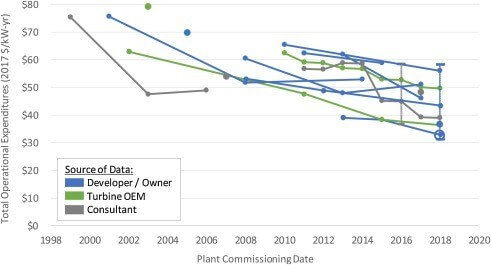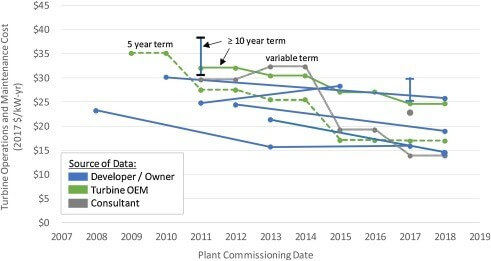News Release from American Clean Power Association (ACP)
Wind Industry Profile of
Wind power costs have plummeted. How can they fall even further?
While a new iPhone may run you several hundred dollars today, a Motorola DynaTac would have set you back nearly $4,000 in 1983. Wind energy is no exception to this rule—it may have been costly at one time, but today wind is the cheapest source of new electric generating capacity in many parts of the country. In fact, wind today costs 69 percent less than it did in 2009.
Even better, there’s plenty of room for wind’s costs to continue their sharp decline, according to a new report from Lawrence Berkley National Laboratory (LBNL) and the National Renewable Energy Laboratory (NREL).
Wind’s previous cost declines were largely driven by technological advances that allow modern turbines to reach stronger, steadier winds. That lets them generate more electricity at a lower cost. Improvements in domestic manufacturing and economies of scale also made it cheaper to build new wind turbines. While there are still gains to be made in these areas, operations expenditures (OpEx) present a huge opportunity for new gains and were the focus of NREL and LBNL’s new study.
Why OpEx matters
Operational expenditures (OpEx) represent a large and growing share of a wind farm’s levelized cost of energy (LCOE). According to the LBNL/NREL study, OpEx accounts for between 25 and 35 percent of a project’s overall levelized cost of energy (LCOE).
And here’s where the cost savings come in– the labs estimate a 9 percent decline in OpEx results in roughly 10 percent of the future decrease in the LCOE, on average. As a result, reducing OpEx is essential to achieving lower LCOE and making wind even more cost competitive.
For example, operations and maintenance (O&M) expenditures are included in OpEx, and O&M is where some of the most exciting, high tech advances are being made, like drone deployment, the use of big data, predictive analytics and artificial intelligence.

What did LBNL/NREL study find?
The data shows a prominent downward trend in all-in levelized lifetime OpEx. All sources were consistent in reporting that for projects built in the late 1990s, the lifetime OpEx average was about $80/kilowatt (kW) per year. But the anticipated lifetime OpEx for more recent projects fell to low-mid $40s/kW per year. So just like a laptop today costs less than one from the late 90’s, OpEx costs for a wind farm built today are less than one built 20 years ago.
There are a variety of factors that contribute to this decline. As America’s wind fleet grows, emerging economies of scale reduce costs. Further cost savings are a result of matured technology, more reliable components, and the growing demand for “full wrap” contracts, O&M agreements that include full coverage for equipment maintenance and repair.

What can a wind farm do with OpEx savings?
Lower OpEx costs are allowing wind farms to operate longer. Over time, turbines accumulate site-specific fatigue damage, the normal wear and tear associated with long-term equipment use. With better operations and management, site specific accumulated fatigue damage can in many cases become lower than design-certification fatigue damage, or wear and tear that comes from outdated design and technology. This makes the initial 20 year estimate of a turbine’s life obsolete. Improved technology, operations and management practice, and competitive pressures show that there’s an increased economic lifetime of 25 to 30 years.
The report’s authors concluded an OpEx-based learning rate of 9 percent over the 1998-2018 period, meaning that all-in OpEx in the U.S. has declined by 9 percent for each doubling of global wind capacity. This means that OpEx has also been a significant factor in reducing LCOE. The authors also find there’s ample room for continued OpEx reductions, which will further decrease wind’s already highly cost-competitive LCOE.
Enhancements on past mechanisms, greater economies of scale, additional research, and experience are expected to yield better component reliability, increased competition, and further standardization and application of technology for predictive maintenance. This is likely to drive OpEx lower. The authors report the learning-based OpEx estimates suggest continued OpEx reductions may contribute to 10 percent or more of the overall land-based wind LCOE reductions expected through 2030.
So an affordable energy source has room to grow even more affordable. That’s welcome news for everyone’s electric bills.
- Source:
- AWEA Blog - Into the Wind
- Author:
- Molly Lumsden
- Link:
- www.aweablog.org/...
- Keywords:
- AWEA, Opex, study, costs, decline, wind energy, technology, LCOE, NREL

























